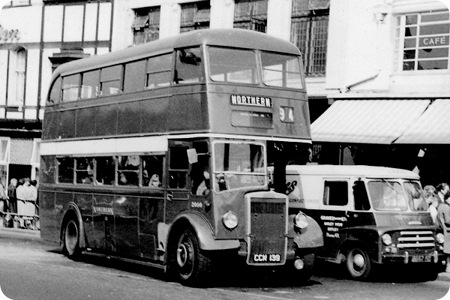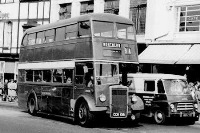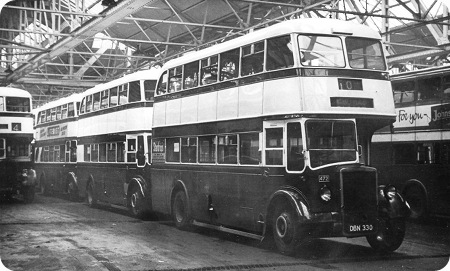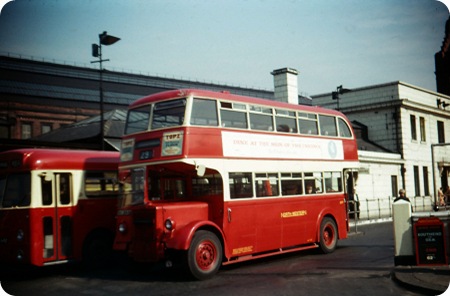Northern General – Leyland Titan PD2/3 – CCN 139 – 2080

Photograph by ‘unknown’ if you took this photo please go to the copyright page.
The Northern General Transport Company
1951
Leyland Titan PD2/3
Leyland H33/26R
This is a photo of a very typical all Leyland Titan of the period the only thing that would be different to a thousand other all Leyland Titans would be the layout of the destination blinds. They were good, solid, reliable and economical workhorses so why change a winning formula, I am not sure just how many all Leyland Titans were built it would be interesting to know, if you know please leave a comment.
This bus was not new to Northern General it was originally delivered to Gateshead and District Omnibus Company a subsidiary of Northern General and was number 39 in there fleet.
I do like the van at the side of the bus, if memory serves me correct I think it was called a ‘Morris Commercial’ but nick named a ‘Morris Comical’ its predecessor which was not as long was narrower but just as tall with a rather strange radiator grill. Anyway that’s enough wandering off the point this is a website for buses not vans.
A full list of Titan codes can be seen here.
———
Just thought I’d ask if anyone can clear up a mystery.
The final version of the Leyland body on PD2s was one of the best and most handsome around. It was derived from the earlier, more stark, version without radiused corners to windows.
The 1951 batch for Sheffield Corporation had rain guttering over the bays and half-drop windows. Making them different from any before or after. Most buses had gone to sliders rather than half-drop other than London Transport with the RT and RM family.
This Northern General Titan of similar vintage has similar detailing, as have all the other 1950/51 examples I have seen (or their photographs) recently.
Was it deliberate Leyland policy or just a coincidence?
David Oldfield
———
I remember seeing these buses regularly in the early 1950s to 1967 approx, very smart indeed in their chocolate brown livery cream relief bands edged in black when in their original Gateshead Omnibus Company livery. Two at least CCN162 and CCN 171 ended their days operating with T D Alexanders "Greyhound" company at Arbroath. Note the unusual two aperture rear destination screens See this link.
Gerald Walker
———
07/03/11 – 08:28
The van is a Morris LD (Light Delivery) the Morris Commercial you refer to was the PV (Parcel Van model)
Roger Broughton
———
25/09/11 – 15:30
Northern General had a number of PD2’s with several different types of bodies, MCW Orion and Park Royal with rear doors were two I can remember, but for some strange reason Percy Main depot (Tynemouth & Wakefields)where I worked, we had five PD2’s with Willowbrook bodies, they were AFT 49 to 53 and the fleet numbers were 219/223
Ronnie Hoye
———
18/01/12 – 06:37
P.S to my previous comments, if you go to Google and type in AFT 53, you will find a picture of one of Tynemouth’s Willowbrook bodied PD2’s fleet number 223 being used a a driver training vehicle. The next batch of buses at Percy Main were the first 30ft vehicles, they were Orion bodied PD3’s registration AFT 924/35 234/5 carried the Wakefields name as did the first Leyland Atlantean CFT 636 fleet no 236. Some of the PD3’s were later transferred to Gateshead but ATF 930 ‘230’ became the training vehicle replacing 223
Ronnie Hoye
———
18/01/12 – 10:34
Not the most attractive of bodies, Ronnie, not helped by the heavy upstairs opening vents.
Chris Hebbron
———
18/01/12 – 13:48
You’re not wrong Chris, but I don’t think they were best suited to this particular livery. the Northern group had several layout changes, when these buses first came they were all maroon with cream roof and centre band, but I always thought that they looked best in the all maroon with cream band, that was the style adopted for the ‘red fleet’ by the time the PD3’s came onto the scene, Sunderland and District remained in their dark blue and white, and Gateshead at first changed from chocolate and cream to the same green and cream livery as Tyneside but later went to all green with cream centre band
Ronnie Hoye
———
 Vehicle reminder shot for this posting
Vehicle reminder shot for this posting
———
19/01/12 – 05:24
It’s amazing that the fleet livery changes should be so many. And it’s amazing what a difference the right livery makes. Sometimes, a woman should be consulted, as long as there’s a veto on pink and princessy! Whatever, the principle is keep it simple!
Chris Hebbron
———
19/01/12 – 12:28
Funny you should say that Chris, I don’t know where it came from or how long they had it ‘it may well have been a demonstrator’ but for a short while in the 70’s, Moor Dale Coaches had a Plaxton bodied Bedford in a Purple Lilac and White livery, it sounds hideous but in actual fact it did look quite attractive, but don’t tell anyone I said that, but you’re right about livery making all the difference, bright trim is also a factor. Moor Dale’s livery was Scarlet, Royal Blue and White, they seemed to favour Plaxton bodied Bedford’s, and they always seemed to stand out from the crowd, at the same time they had four ‘I think’ old double deckers of various types that were used on school runs, and whilst they carried the same colours they never seemed to look right.
Ronnie Hoye
———
19/01/12 – 13:24
I know what you mean, Ronnie, about getting the colour-scheme right. Here are two local examples near me, worth mentioning.
Although I’m not a lover of swooping liveries, this Leyland Olympian, in Swanbrook livery of green, purple and white, works, IMHO, probably because of the expanse of white top. Unusually, for Swanbrook, this bus has a glossy finish! They operate a few stage services in Gloucestershire, but mainly do school runs. See: //www.flickr.com/photos/
This Leyland Olympian with Gloucester operator, Bennett’s Coaches, has a pleasant, more or less, traditional livery. The somewhat disparate colours, with tricky orange, work together, aided by chrome hubcaps. Bennett’s (coach and NatEx operator) have no stage services, but operate Park and Ride and school services. This vehicle is on a layover from P&R duties, usually performed by swish coaches. See: //www.flickr.com/photos/
Of course, I may have no taste for colour at all, being colour-blind! That’s why I got married, so that I could have a dress advisor! Of course, that’s between you and me!
Chris Hebbron
Quick links to the - Comments Page - Contact Page - Home Page


